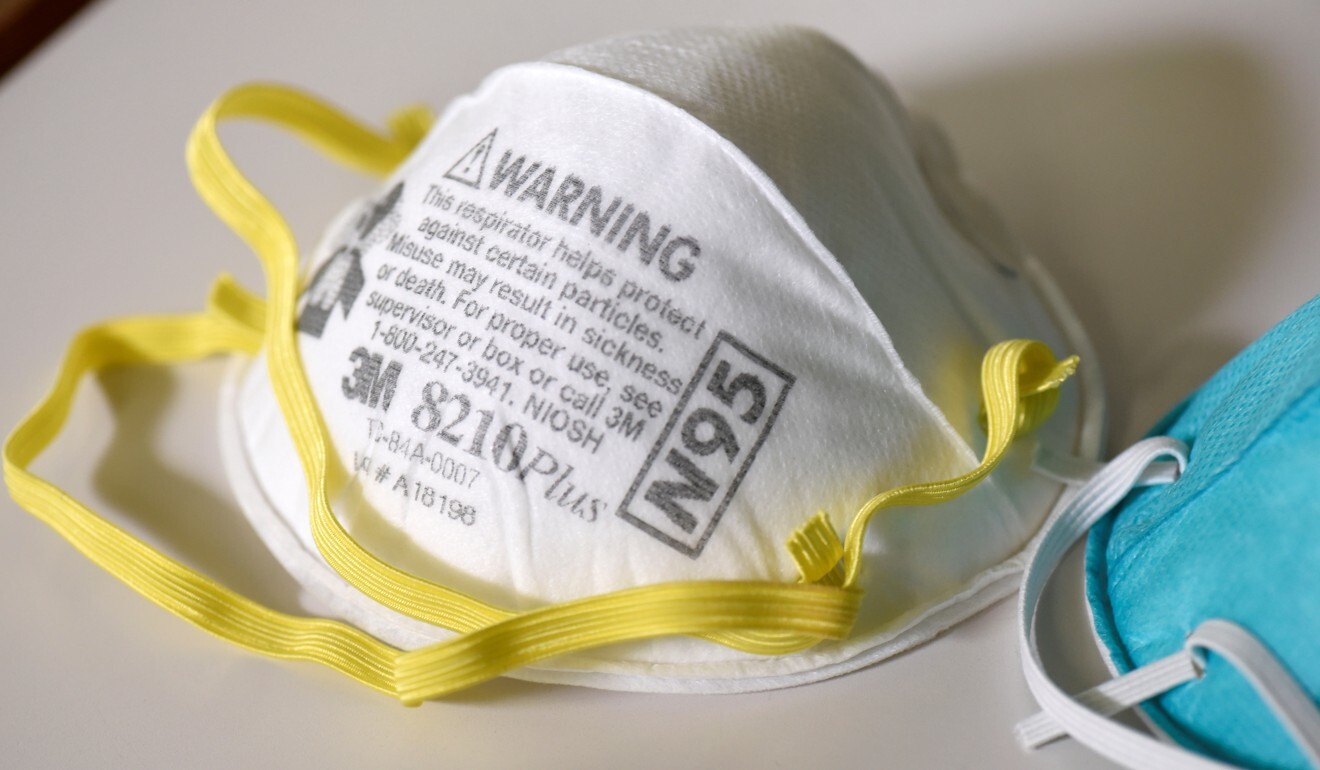Coronavirus mask mystery: why are US officials dismissive of protective covering?
- Other nations recommend wearing masks to avoid coronavirus, but the Trump administration has not seen a benefit

This story is published in a content partnership with POLITICO. It was originally reported by Ben Schreckinger on politico.com on March 30, 2020.
In recent weeks, facing public uncertainty about coronavirus and a severe domestic shortage of medical-grade face masks, top Trump administration officials offered adamant warnings against widespread use of masks, going so far as to argue that members of the general public were more likely to catch the virus if they used them.
“You can increase your risk of getting it by wearing a mask if you are not a health care provider,” Surgeon General Jerome Adams said during an appearance on Fox & Friends earlier this month.
“If it’s not fitted right you’re going to fumble with it,” warned Health and Human Services Secretary Alex Azar late last month, when asked about N95 respirator masks.
“Right now, in the United States, people should not be walking around with masks,” said Dr Anthony Fauci, an immunologist and a public face of the White House Coronavirus Task Force, on CBS’ 60 Minutes earlier this month. He, like the others, suggested that masks could put users at risk by causing them to touch their face more often.
But as the crisis has played out around the world and intensified in parts of the US, reasons have emerged to doubt the wisdom of this guidance, which ranks among the most forceful warnings against mask use by national health authorities anywhere and does not differentiate between medical-grade masks and simple cloth coverings. A number of societies where mask use is more widespread, and where mask shortages have been less severe, seem to have had more success containing the virus.
Now, some health experts, who say there is no evidence for the claim that masks increase users’ risk of catching the virus, are calling for more widespread use of face coverings in the US.
“Guidance needs to change and needs to be clear that these non-medical, non-surgical masks are beneficial to the general public and should be worn when outside of the home,” said Robert Hecht, a professor of epidemiology at the Yale School of Public Health.
The increasing calls for more use of masks raise the question of whether authorities’ recommendations were based on genuine concerns about spreading Covid-19 or instead motivated by a desire to prevent a run on limited supplies of masks: “Seriously people – STOP BUYING MASKS!” tweeted Adams in late February. They are NOT effective in preventing general public from catching #Coronavirus but if health care providers can’t get them to care for sick patients, it puts them and our communities at risk!”
Katie Miller, a spokeswoman for Vice-President Mike Pence, who chairs the White House Coronavirus Task Force, referred questions to the Department of Health and Human Services. Neither the surgeon general’s office nor the HHS press office responded to emails or phone calls requesting comment.
In response to emails requesting comment from Fauci, Elizabeth Deatrick, a spokeswoman for the National Institutes of Health, referred questions to the Centres for Disease Control.

“At this moment, there are no updates or anticipated changes to the guidance,” said Arleen Purcell, a spokeswoman for the Centres for Disease Control, who reiterated existing CDC guidelines that patients with symptoms should wear masks but that people who are well should not wear the masks to prevent contracting the virus. Unlike the verbal warnings from top health officials, the CDC’s written guidance does not suggest that wearing a mask could increase the risk of catching the virus.
Purcell did not address questions about the assertion that masks could increase users’ risk of catching the virus or whether the CDC was studying coronavirus responses in other parts of the world where face mask use had been more widespread.
Asked on Monday about suggestions that mask-wearing could prevent transmissions, President Donald Trump offered a non-committal response. “We haven’t discussed it, be we could. We are getting the number of masks you need,” he said. “We will take a look at it.”
Trump also suggested that wearing masks might be a way to help people get back to work. “We are not going to be wearing masks forever, but it could be for a short period of time after we get back in gear.”
The current federal guidance against wearing masks is at odds with that issued in many other parts of the world, such as the Czech Republic, Beijing and Shanghai, where mask use has been mandated for anyone going out in public. A number of east Asian societies, where mask use is widespread – such as South Korea, Hong Kong and Singapore – have reported lower levels of infection than the US has, despite being closer to the source of the outbreak in Wuhan, China. In Taiwan, where reported levels of infection are also relatively low, authorities have called for people to use face masks whenever they are in enclosed spaces, such as public transport.
Some Western authorities and public health experts have also begun calling for more widespread use of face masks. On Monday, the government of Austria mandated the use of face masks for anyone entering a supermarket.
Days earlier, the German Medical Association, that country’s umbrella organisation for doctors, issued new guidance on Thursday urging citizens to find a simple fabric mask or make one themselves, and to wear it in public while foregoing medical-grade masks.
A group of mostly UK researchers, publishing in The Lancet, a top peer-reviewed medical journal, on March 20, recommended that “vulnerable populations, such as older adults and those with underlying medical conditions, should wear face masks if available. Universal use of face masks could be considered if supplies permit”.
As of Monday, US federal authorities were not budging. William Schaffner, a professor of preventive medicine and infectious diseases at Vanderbilt University Medical Center in Tennessee, said that CDC experts were “very loath” to issue recommendations that were not based on robust data.
But Schaffner, who keeps in touch with government health officials, told POLITICO that the possibility has been broached within the CDC of issuing guidance suggesting the public use “mask alternatives” while at the same time disclaiming a lack of published studies showing them to be effective for general use in public settings.
“I do not know how far those discussions have gotten along,” Schaffner said.
He said that data suggesting that people could prevent catching the virus by wearing masks in public was “scant”. But he added, “the absence of data doesn’t mean the absence of effect”.
Shan Soe-Lin, a lecturer in global health at the Jackson Institute for Global Affairs at Yale University, said there is enough data showing face coverings are effective for use by the general public that people should be using them. “Admittedly, the studies are small,” she said, but there is evidence that “In pandemic settings, masks can be helpful.” Soe-Lin and Hecht, who are married and run the non-profit Pharos Global Health Advisors, authored a Boston Globe op-ed earlier this month that called into question federal guidance and urged people to begin wearing face masks – including basic face coverings like a scarf or bandana – while continuing to prioritise the distribution of medical-grade masks to hospitals.
As for federal officials’ argument that wearing a mask will cause people to touch their face more often, Soe-Lin said she has looked for studies that back such a finding and found none. Both she and Hecht said that in their personal experience, they have been touching their faces far less often since donning face coverings.
Schaffner also said he was aware of no data showing that wearing a mask could increase risk by making people touch their face more. He said he was also not aware of data showing that wearing a mask could cause a user to touch their face less often, but he said that in his own personal experience, he, too, tends to touch his face less often when he wears a mask to treat patients.
Recommendations about the use of face masks have diverged widely from place to place, and can vary based on local availability as well as the type of face mask. Public health authorities both in the US and around the world have called for prioritising face mask allocation to health care providers and those infected with the virus.

Mask recommendations are complicated by a number of factors, including the various types of coverings that exist. N95 respirator masks are the most effective in impeding transmission and can filter out smaller particles than other masks. Simple surgical masks are more plentiful but less effective. In some places, handmade cloth masks or simple face coverings like scarves or bandanas are being used.
Experts say masks are more effective at preventing virus carriers from spreading the disease than they are at preventing healthy users from contracting it.
But there is no consensus on how effective they are as a preventive measure for healthy people. And it is not yet known how contagious asymptomatic carriers of coronavirus are, further complicating guidelines for infected people.
“If you mandated that the entire population had to wear a mask when they went out, all those asymptomatic carriers that are now transmitting it through respiratory droplets it would be much harder for them to transmit it,” former FDA Commissioner Scott Gottlieb said during a video chat interview with The Wall Street Journal last week.
Recommendations also vary based on categories of people and setting. Experts generally urge health care workers and others caring for infected people to use face masks. Some experts and authorities have gone further, recommending in some cases that older people or others who are especially vulnerable to the virus should wear face masks in public, or that anyone venturing into enclosed spaces – like subway trains – should wear one.
In general, Western authorities and the World Health Organisation have issued guidance calling for more limited use of face masks, while authorities in East Asia have tended to recommend, or mandate, more widespread use of masks.
That difference echoes a pre-existing cultural divide, in which face mask use was already widespread in parts of east Asia, which has been the site of other virus outbreaks in recent decades and is characterised by a large number of dense urban areas.
In the US – where face masks are rarely seen outside of clinical settings – hospitals have struggled to secure adequate supplies. In February, Azar testified that the federal government had only 30 million respirator masks stockpiled, but that the country needed at least 10 times that number to weather the outbreak. When there are shortages of surgical and N95 respirator masks, as there currently are in the US, experts broadly agree that hospitals should have priority in securing such masks.
But that is a separate question from that of whether masks could be harmful to users, or whether the general public should be using face coverings.
“Any possible additional protection that we can get and that we can employ,” Soe-Lin said. “I don’t think we should sneeze at that.”